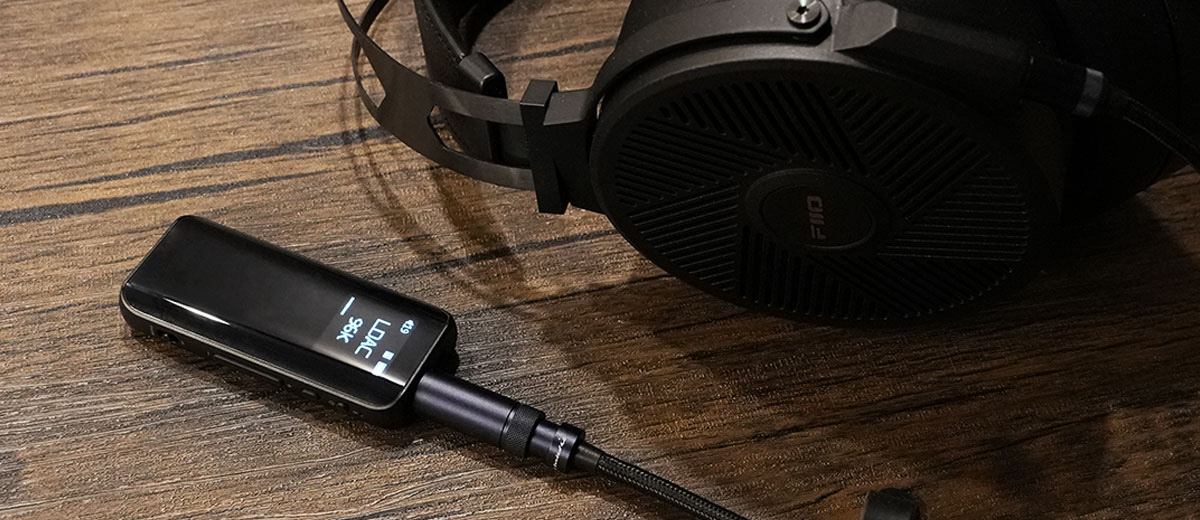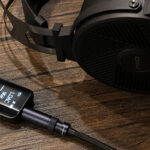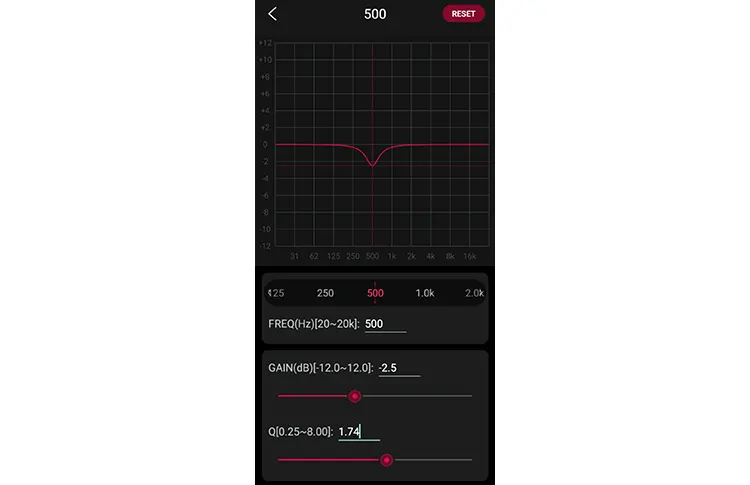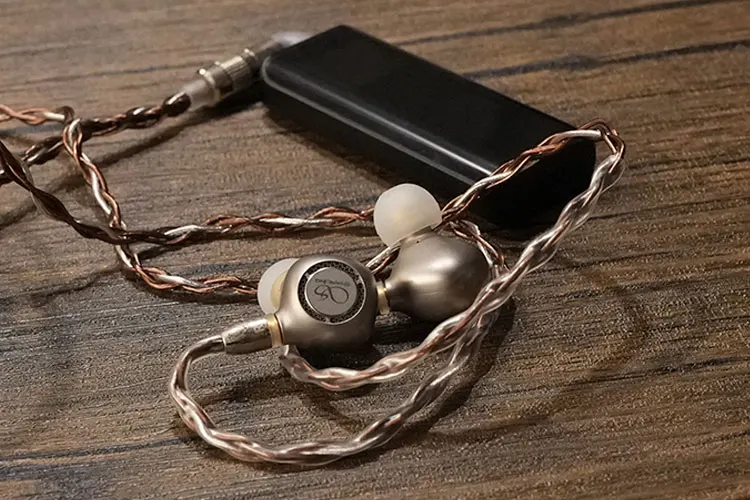In this feature, we review the FiiO BTR15, which is a Bluetooth and balanced output-capable wireless dongle DAC featuring a dual ES9219MQ DAC. It is priced at $109.99 SRP.
Disclaimer: This was sent to us as a sample in exchange for our honest opinion. Headfonics is an independent website with no affiliate links or services. We thank FiiO for its support.
You can click here to learn more about the FiiO audio products we have previously assessed on Headfonics.
Note, that this post follows our current scoring guidelines which you can read in more detail here.
The BTR5 Bluetooth dongle DAC and its successor, the BTR5 2021 edition were some of the most popular reviews on Headfonics but time does not stand still in terms of technology so a 2 year wait for an updated model seems about right.
And indeed, it is updated. The new BTR15 version now comes with a 4.4mm jack, stronger power, dongle, and USB-powered modes, and even a Parametric EQ function that can be adjusted in the app.
Our original review had the BTR5 listed at $119.99 so I am surprised the BTR15 has come out with a new lower price of $109.99.
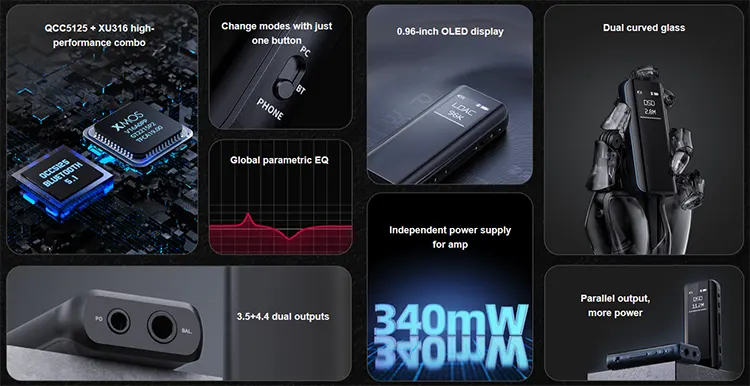
Tech Highlights
Qualcomm QCC5125
The BTR15 is, as before, a wireless dongle DAC with wired capability to operate as a small battery-powered USB-DAC. However, despite some resemblance to its predecessors, the specifications have been enhanced.
This includes an upgraded Bluetooth solution, transitioning from the common Qualcomm CSR8675 to the higher-end QCC5125 chipsets, which support Bluetooth 5.1. It also supports aptX Adaptive and HD, LDAC, and can handle sampling rates of up to 96kHz wirelessly.
Decoding
The BTR15 incorporates dual ESS ES9219MQ DACs and features a discrete power circuitry designed to enhance current output with improved noise control. When used as a wired USB DAC, it supports decoding of up to 32bit/384kHz and DSD256.
The Bluetooth section is coupled with an upgraded XMOS USB solution, transitioning from XU208 to XU316, resulting in enhanced performance. Additionally, the design maintains the dual crystal oscillators from the previous generation, which helps provide superior jitter control.
Amplification
The BTR15 offers a notable power increase compared to its predecessor, the BTR5. It is capable of delivering up to 340mW of power at 32Ω, which represents a significant 140% improvement.
Additionally, it provides 165mW to 16Ω loads through a single-ended connection, nearly doubling the output power of the BTR5 2021 model.
A noteworthy feature of the BTR15 is its 60 levels of independent adjustment, which allows for more precise control over sensitive audio equipment, enabling fine adjustment.
Furthermore, the BTR15 employs Low Dropout Regulators to supply power to the decoding and amplification sections. This ensures a stable and clean power supply, resulting in improved sonic performance.
Design
Weighing just 36g, the BTR15 features elegant, curved glass panels on both the front and back, seamlessly blending with its metallic, matte sand-blasted framework. The front of the device showcases a clean and clear 0.96″ OLED screen.
Additionally, a microphone is located near the power button, allowing the BTR15 to effectively capture your voice during calls.
In personal testing, it performed well outdoors, delivering sufficient loudness and clear voice transmission, as confirmed by the other party on the call.
I/O
At the bottom of the BTR15, you will find the 4.4mm, and 3.5mm jacks neatly aligned. This upgrade to include the 4.4mm output is a sensible decision, although it may be considered slightly delayed as many devices have already transitioned to 4.4 jacks.
On the other side is a USB-C socket, the layout is carefully designed to use every inch of space. The installation of these jacks helps maintain a slim profile and ensures a secure connection without any noticeable shaking or instability.
Controls
Mode switch
The BTR15 introduces a convenient new mode switch designed by FiiO. Located on the sides of the device, this switch allows users to easily toggle between PC, Phone, and Bluetooth modes.
PC mode enables USB-powered functionality, Phone mode operates with device power while wired, and Bluetooth mode enables wireless connectivity.
This streamlined approach eliminates the need to navigate through system menus to switch between modes. Additionally, the device features volume adjustment buttons on the sides, providing a clean and satisfying click response.
In PC mode, if the BTR15 is not turned on, it will charge the device. While there is no quick charge hardware installed, the device can fully charge in less than an hour, offering up to 8 hours of playback time.
Control App
In addition to the physical controls, the FiiO Control App provides further access to settings on the BTR15. Through the app, users can fine-tune the onboard Parametric Equalizer (PMEQ) by selecting the desired Q value.
This adjustment can be applied not only when connected via USB but also when using Bluetooth. The app also offers options to adjust system timeouts, customize key functions, and select preferred codecs, among other settings.
Parametric EQ
In addition to adjustable EQ presets and gain settings, the BTR15 incorporates an app-controlled parametric equalizing function, empowering users to fine-tune the audio output.
This feature enables precise adjustments in multiple frequency ranges, with the ability to modify the Q value for more targeted control.
It is a highly recommended feature that significantly enhances the perceived performance. For instance, users can reference online resources to identify the frequencies of different elements in the music and effortlessly smooth out peaks or add more depth to vocal tones.
Packaging & Accessories
The BTR15 package includes a short USB-C to USB-C cable, allowing you to use it as a dongle for connecting to phones. Additionally, it comes with an adapter for PC connections, providing versatility in usage.
Inside the box, you will also find a transparent hard clip that allows you to securely attach the BTR15 to your bag or pants, offering convenience if you prefer not to keep it in your pocket.
The slim and lightweight design of the BTR15 makes it easy to forget that it’s even there, enhancing portability and comfort during use.
Sound Impressions
Having given the BTR15 over 100 hours of run-in, the following impressions were put down pairing it with various IEMs under both Bluetooth and PC modes, with High gain and Fast filter settings.
Summary
The BTR15 excels not only as a Bluetooth receiver but also as a capable USB DAC. When using it with a laptop, it is recommended to connect it via a wired connection rather than relying solely on Bluetooth.
The 4.4mm output on the BTR15 has a rather high output power for a dongle-type product, resulting in improved dynamics and impactful bass compared to previous generations. Additionally, it enhances definition and creates a more spacious soundstage.
Although the single-ended output may have average output power, it maintains a fairly neutral tone and satisfactory resolution. It proves to be more practical compared to previous generations, which delivered less than 100mW into 3.5mm-terminated IEMs.
Bass
With the increased output power, the BTR15 delivers a stronger punch and deeper bass that is more resolving and layered.
The bass response is characterized by fast attacks and clean, airy decay, resulting in an energetic impression. The lower register exhibits good warmth, enhancing the presence of the bass, while drums sound airy and punchy.
During testing, the BTR15 demonstrates some good body in the lower register, making it well-suited for relaxing jazz and bouncy, synthesized basses. It handles symphonic bass and darker voices with good depth, outlining the bass cleanly with ample air and a satisfactory level of detail.
When utilizing the PEQ function to add more rumble to the sub-lows, the BTR15 maintains its strength in resolution and speed. It remains responsive and detailed even at higher volumes, showcasing its ability to handle increased demands while preserving clarity and detail.
Mids
Compared to the BTR5 the BTR15 is more expressive and lively in the midrange, as the higher power seems to bring about better separation, shaping a clearer vocal image.
The vocals and instruments across the mids sound more textured and realistic, though you may find it slightly shy as the underlying bass is always powerful, and pressing down the low mids may help IEMs such as the Shanling ME700 sound much clearer in the mids.
In other words, you may find the sweet spot at a slightly higher volume with bassy gear pairings.
I consider the tone in the mids rather even and smooth, which works nicely with instrumentals and classical music, and nuances are nicely presented when focusing on guitar pickings or bowing details.
Giving the midrange frequencies a gentle nudge with the PEQ function may further enhance the overall balance for vocal works and allow darker voices to cut through with better clarity.
Treble
The BTR15 exhibits smooth articulation from the mids to the treble, with subtle boosts in the higher register that enhance clarity and resolution.
This characteristic empowers softer voices, strengthens harmonics, and adds air in the upper register. It captures the brilliance of woodwinds and upper strings effectively, although sharper voices may come across as overly bright.
Testing the BTR15 with IEMs of higher impedance, the treble is well-controlled and clear. It allows for a satisfactory level of detail retrieval without sounding harsh.
The extension in the treble range is sufficient, as evidenced by the rendition of bells and higher piano notes, and on sensitive gears, you can feel the treble cutting through with more energy.
Staging & Imaging
The newer generation BTR15 demonstrates significant improvements in staging performance and imaging, likely due to enhanced noise control and stronger separation power.
Instruments are precisely positioned, particularly when using the USB-powered connection, allowing for a clear perception of instrument placement and panning effect across the stage.
The soundstage created by the BTR15 resembles that of a lecture hall, with good depth and a sense of the vocalist or instruments slightly distanced across the midrange. Faint reverberation can be picked up, adding to the overall spatial ambiance and engaging listening experience.
Click on page 2 below for our recommended pairings and selected comparisons.

